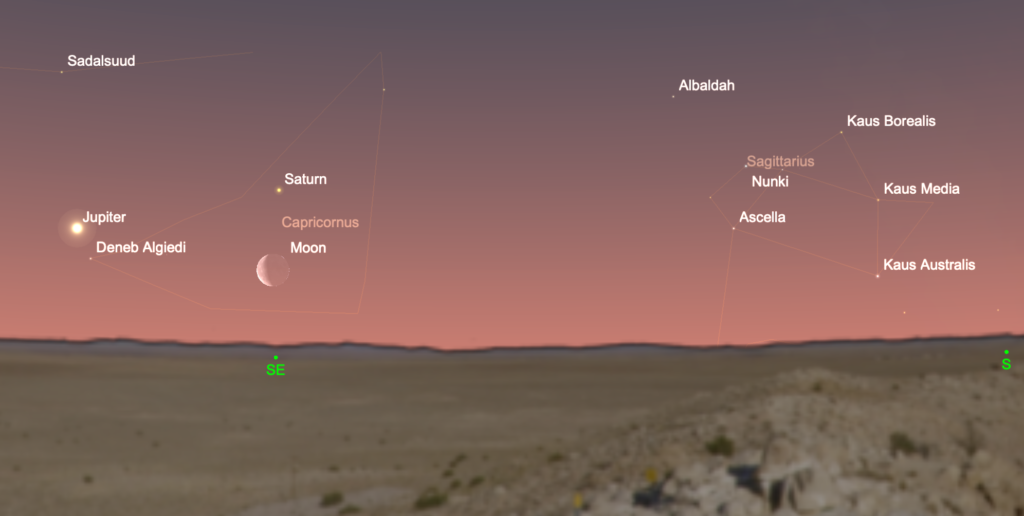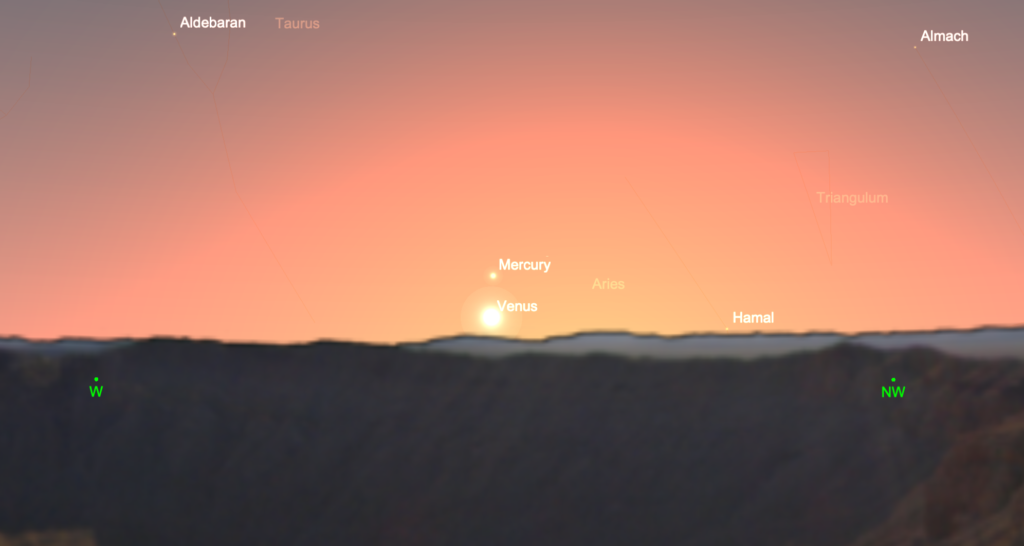
April gets underway as the brilliant constellations Taurus, Orion, and Canis Major turn to the west after sunset and are nearly gone for the year. Early risers can see Jupiter and Saturn in pre-dawn sky. Mars lingers in the southwestern evening sky and rivals the bright stars of Taurus and Gemini. The Lyrid meteor shower puts on a show. Venus re-appears as the ‘Evening Star’ for the rest of the year. And we mark the 60th anniversary of one of the greatest human achievements of all time. Here’s what to see in the night sky this month…
4 April. Last Quarter Moon, 10:02 UT
5-6 April. Jupiter and Saturn have come round the sun since earlier in the year and now appear in the morning sky for the next several months. On April 5th and 6th, Jupiter and Saturn are low over the southeastern horizon at dawn along with a waning crescent Moon. A pair of binoculars help pull them out of the brightening morning light.

12 April. New Moon, 02:31 UT
12 April. Today marks the 60th anniversary of Vostok 1, the first manned spaceflight in which Soviet cosmonaut Yuri Gagarin made a single orbit of Earth. This marked an immense achievement in human history, one achieved by a country devastated by the Second World War only 16 years earlier. The Soviets, for all their manifest faults, accomplished something for the ages with this flight.
It was a decidedly low-tech affair, however. Gagarin’s craft had oxygen tanks strapped to the outside of his capsule, and it tumbled uncontrollably, by design, when it re-entered the atmosphere. Gagarin endured acceleration of up to 8g upon re-entry, and made a planned ejection from his capsule about 7km above ground. When he landed by parachute in a field near the town of Engels, there was no greeting party, only an astonished farmer and her daughter. He recounted, “When they saw me in my space suit, they started to back away in fear. I told them, don’t be afraid, I am a Soviet citizen like you, who has descended from space and I must find a telephone to call Moscow!”
16 April. Mars forms an equilateral triangle nearly 20 degrees on a side with the similarly-colored stars Betelgeuse and Aldebaran in the southwestern sky after sunset. The waxing crescent Moon joins the show. Mars is too small to show much detail in a telescope, but it still shines at a respectable magnitude of +1.4.
18 April. If you have a clear view down to the western horizon, grab a pair of binoculars and look for the planet Venus less than 5 degrees above the horizon just after sunset. The planet has emerged into the evening sky and remains there for the rest of 2021, slowly getting higher and brighter as the year wears on.

19 April. The Moon and the stars Castor and Pollux in Gemini have arranged themselves in a line about 12 degrees long in the southwestern sky after sunset.
20 April. First Quarter Moon, 06:59 UT
20 April. The Moon lies less than 5 degrees from the Beehive star cluster (M44)
22 April. The Lyrid meteor shower peaks in the early-morning hours. This is the first significant meteor shower since the Quadrantids in early January. The Lyrids display some 15-20 meteors per hour in good conditions. The moon, just two days past first quarter, may get in the way of the faintest meteors this year.
The Lyrids trace their apparent paths back to a point between the constellations Hercules and Lyra, both of which rise in the east around midnight. They’re visible all night, but you may have more luck after midnight as the Earth turns into the meteor stream. The Lyrids have made a regular appearance for at least 2,500 years, longer than any other meteor shower. They happen as Earth passes through a stream of debris left by Comet C/1861 G1 (Thatcher).

25-30 April. Look to the western sky
26 April. Mars planet passes just half a degree north of the star cluster M35 in Gemini, a fine event worthy of inspection in binoculars or telescope at low magnification.
27 April. Full Moon, 03:32 UT
29 April. The waning gibbous Moon lies about 4 degrees from the bright star Antares in the constellation Scorpius. Look for the pair low in the south-eastern sky in the northern hemisphere, and nearly overhead in the southern hemisphere.